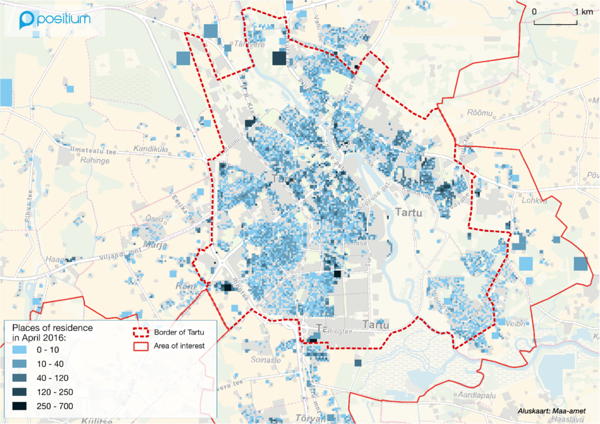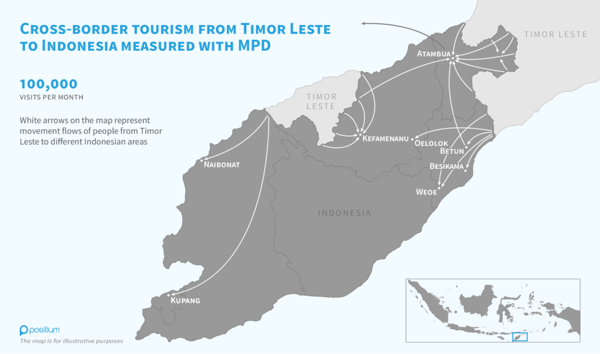With this article, we begin a new series called Methodology Talks, in which we discuss the science and research behind the methodology we have worked or collaborated on for the use of mobile positioning data for generating statistical insights.
Positium constantly works on research and development, not only developing Positium’s Data Mediator (PDM), our methodology and technology platform that turns billions of anonymised location events from mobile positioning data (MPD) into meaningful statistical insights, but also developing standards to use MPD for tourism statistics, decision-making, smart city solutions, and more.
This article focuses on using MPD to generate tourism statistics. Keep reading to learn more about the science that backs this up, case studies, links to academic papers Positium has worked on, the limitations and challenges of this source of big data.
Is It Possible to Use MPD to Generate Tourism Statistics?
MPD can be used for producing official tourism statistics. Several countries (Estonia, Indonesia and most recently Oman) have, in fact, done so. The UN has also released a handbook on the use of MPD for official statistics.
How Do You Get Location Data for Tourism Statistics From Mobile Phones?
For billing purposes, mobile network operators (MNOs) collect data on mobile phones that connect to their cell towers whenever calls are made, SMS messages are sent or mobile data is used. In urban areas, cell towers might be located a few hundred metres from each other. Using methods such as interpolation, it is possible to calculate mobile device locations at an even higher precision than at the cell tower level.
Relevant for tourism, among the data that is collected is the country codes of the mobile phone numbers. This means that it is possible to determine which countries the people using an MNO's services are from via their phones. Additionally, it is possible to distinguish between tourists and people living within the country. For example, if a phone number – whether domestic or foreign – is present for at least six months in the country within a one-year time frame, they are considered a resident and removed from tourism data.
Positium has completed MPD projects for official tourism statistics using pseudonymised data from MNOs and United Nations (UN) guidelines and definitions. This way, our data processing practices are aligned with the fundamental principles of official statistics production established by the UN, European Union and other organisations.
Additionally, the process is transparent, allowing for verification and validation. Positium’s projects are GDPR (EU General Data Protection Regulation) compliant and follow European and UN regulations on data privacy. Analysing the data does not allow for identifying specific people, instead the data is processed according to reliable methodology which creates aggregated results.
To learn more about MPD, read our article ‘Mobile Positioning Data FAQ: MPD Basics’.
What Are the Main Advantages of Using MPD for Producing Tourism Statistics?
MPD has several major advantages over more traditional sources. For one, sample sizes are considerably larger since mobile phones have a high penetration rate. While accommodation registry data only covers tourists who stay overnight in official accommodation establishments, MPD also features data on tourists who spend the night in other types of accommodation (e.g. visiting friends or family), as well as on same-day visitors. Meanwhile, official entry records of a country are valuable but this data is not always collected or reliable. This is especially true for contexts such as the Schengen Area where – because of the free movement of people between countries – data on border crossing is much harder to collect. Because of this, MPD is again valuable as it covers everyone entering or exiting a country and carrying a mobile phone.
Unlike with traditional data sources, MPD can be used to map out tourist mobility within a country. This can be done on different scales, such as looking at movement from one state/province/county to another or at more detailed movements within a city. This offers a range of opportunities for analysis, such as information on sights or transportation corridors that are popular with tourists.
Another major benefit of producing statistics from MPD is that it is cost- and resource-efficient. It does not put any burden on the tourist via forms that need to be filled out. It is also timely. With traditional sources (especially censuses), collecting, processing and releasing the data tends to be time-consuming, whereas with MPD, results can be produced in near real-time.
An often overlooked domain is domestic tourism. Domestic tourism tends to be harder to measure, due to a lack of border crossing data, as well as a higher likelihood of same-day visits or stays at non-official accommodation establishments. Because MPD can be used to determine home and work locations with quite a high spatial precision, presence in parts of the country that are not in the person’s usual environment can be categorised as tourism. Additionally, based on the length of stay, locations can also be categorised as secondary homes. This can be highly valuable for mapping out domestic tourism trends such as travel to summer cottages.
MPD provides unique opportunities for event statistics. Event data can be a valuable subcategory of tourism statistics. MPD can be used to measure how many people visit an event, where the visitors come from (from where within the country or from what other country) and how long they stay. These are things that are not possible to measure with traditional sources. As an example, Indonesia used MPD to assess the 2018 Asian Games and the impact the event had. In Tartu, Estonia, MPD was used to analyse a 2019 Metallica concert. The data allowed gaining valuable insights on where people arrived from and how long they stayed in Tartu.
What Are the Limitations of MPD?
To be clear, MPD is not suitable for all types of official tourism statistics and will need to be supplemented by other data sources. It is primarily a quantitative source. As such, it is not possible to determine the purpose of the trip, although based on the length and movement patterns of a trip, it can be categorised as transit, migration, cross-border commuting or a tourism visit. Additionally, while MPD is powerful in providing a location for where tourists spend the night, it is not able to differentiate between various accommodation types.
What Are the Challenges and Difficulties of Using MPD and How Has Positium Faced Them?
One of the challenges is access to MPD from MNOs. Clear co-operation between statistical institutes, MNOs and potentially other actors will need to be established. Since there are typically multiple MNOs present within a country, it is ideal to gain access to data from all of them for complete market penetration, but this can be particularly challenging. However, even with access to data from a single MNO (e.g. with around 30% market penetration rate), it is possible to extrapolate the results to the general population. This has been the case for numerous projects that Positium has been involved with.
Another challenge is extracting socio-demographic data from MPD. MNOs do collect additional information such as gender and age, but this is generally highly unreliable as this information is tied to the person who is in charge of the phone plan and not necessarily the users themselves. For example, a family plan might include four people but only the information regarding the payer of the subscription is included. For this reason, Positium has stayed away from promising to offer data on age and gender.
There are, however, certain types of socio-demographic data that can be collected with MPD. For example, in the Estonian market, Positium has been able to differentiate between Estonian and Russian users based on whether a mobile phone plan is in the Estonian or Russian language.
Tourists using local SIM cards while present in the country present another issue since they show up as citizens of the country rather than international tourists. Even if they do not use local SIM cards, tourists might turn off roaming on their phones for their visit, making them invisible. Additionally, it is possible that the foreign country a SIM card is registered to is not the country where the person is from. Because of such potential issues, it is important to have reference data to measure MPD against. If particular anomalies appear, it is important to analyse them further and determine potential reasons for these.
Are There Enough Success Stories and Early Adopters to Support the Readiness of Using MPD for Tourism Statistics?
With the help of Positium, Estonia has consistently been using MPD for official tourism statistics already since 2008. Since then, Eesti Pank (Central Bank of Estonia) has been responsible for cross-border tourism statistics in calculating imports and exports of travel services for the current account of the balance of payments.
Read the case study about Eesti Pank ‘Estonia Leads the Production of Tourism Statistics Using Mobile Positioning Data’.
BPS-Statistics Indonesia has been using MPD for official statistics since 2016. Because Indonesia has land borders with several countries as well as an extensive sea border, there have been major coverage issues measuring cross-border movement using only administrative data. Using MPD has significantly improved the quality of data on border crossing.
In Oman, MPD has recently been used for mobility (including tourism) statistics. This has allowed gaining access to new and valuable types of tourism data, which has revealed some surprising movement patterns.
If you wish to read more about Positium’s methodology, you can check out a list of academic papers we have published or collaborated on here, or you can also follow our Zotero group here.
Would you be interested in learning more about mobile big data and Positium? Let's talk about what mobile big data can do to help your organisation make decisions based on population mobility.
.png)

